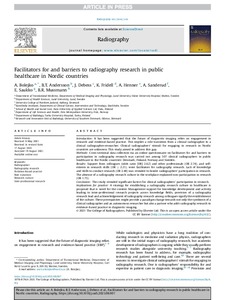Facilitators for and barriers to radiography research in public healthcare in Nordic countries
Debess Jeanne; Mussmann Bo Redder; Fridell Kent; Bolejko Anetta; Henner Anja; Saukko Ekaterina; Sanderud Audun; Andersson Bodil T.
https://urn.fi/URN:NBN:fi-fe2021102752624
Tiivistelmä
Introduction: It has been suggested that the future of diagnostic imaging relies on engagement in research and evidence-based practice. This implies a role transition from a clinical radiographer to a clinical radiographer-researcher. Clinical radiographers’ stimuli for engaging in research in Nordic countries are unknown. This study aimed to address this gap.
Methods: Cross-sectional data collection via an online questionnaire on facilitators for and barriers to participation in radiography research was carried out among 507 clinical radiographers in public healthcare in the Nordic countries: Denmark, Finland, Norway and Sweden.
Results: Support from colleagues (odds ratio [OR] 2.62) and other professionals (OR 2.74), and self-esteem in research skills (OR ≥ 2.21), were facilitators for radiography research. Lack of knowledge and skills to conduct research (OR 2.48) was revealed to hinder radiographers’ participation in research. The absence of a radiography research culture in the workplace explained non-participation in research (OR 1.75).
Conclusion: This study revealed significant factors for clinical radiographers’ participation in research.
Implications for practice: A strategy for establishing a radiography research culture in healthcare is proposed that is novel for the context. Management support for knowledge development and activity leading to inter-professional research projects across knowledge fields, provision of a radiography research lead and acknowledgement of radiography research among colleagues signify the establishment of the culture. These prerequisites might provide a paradigm change towards not only the symbiosis of a clinical radiographer and an autonomous researcher but also a partner who adds radiography research to evidence-based practice in diagnostic imaging.
Kokoelmat
- Rinnakkaistallenteet [19207]
